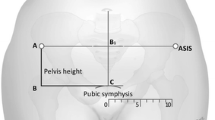Abstract
Objective
Early detection of malnutrition in newborn babies is of major importance in order to prevent associated serious sequelae. Main objective of the study was to compare various anthropometric methods with Clinical assessment of nutritional status score (CANSCORE) in assessing fetal malnutrition.
Methods
Subjects were consecutive, live, singleton, full term neonates delivered in the hospital. The mean weight, chest circumference, mid arm circumference, and Ponderal index of babies and CANSCORE described by Metcoff4 were assessed and compared.
Results
A total of 442 term singleton live born neonates were assessed. They consisted of 228 [51.6%] males and 214 [48.4%] females. Eighty-three [18.8%] of the 442 babies had fetal FM. The mean weight, mid arm circumference, and Ponderal index of babies with FM were significantly lower than those of babies without FM (p < 0.0001). Though the mean head circumference and the length of the babies with FM were also lower, the differences were not statistically significant (p = 0.50 and 0.79 respectively). However, using intrauterine growth standard alone, 41 (49.4%) of the 83 babies with fetal malnutrition would have been missed while Ponderal Index would also have missed 51 (61.4%) of the babies with FM.
Conclusion
CANSCORE is likely to be very useful in the routine screening of babies for anticipatory care.
Similar content being viewed by others
References
Lockwood CJ, Weiner S. Assessment of fetal growth. Clin Perinatol 1986; 13: 2–35.
Georgieff MK, Sasanow SR. Nutritional assessment of the neonate. Clin Perinatol 1986; 13: 72–89.
Jayant D, Rajkumar J. Study of the prevalence and high risk factors for fetal malnutrition in term newborns. Ann Trop Paediatr 1999; 19: 273–277
Metcoff J. Clinical assessment of nutritional status at birth. Fetal malnutrition and SGA are not synonymous. Pediatr Clin North Am 1994; 41: 875–891.
Adebami OJ. The Prevalence and Problems of Fetal Malnutrition in Term Infants at Wesley Guild Hospital, Ilesa, Southwestern Nigeria. A Dissertation Presented to the West African College of Physicians in part-fulfillment of the requirements for the Fellowship of the College in Paediatrics, April 2004.
Altman DG, Hytten FE. Intrauterine growth retardation. Lets’ be clear about it. Br J Obstet Gynaecol 1989; 96: 1127–1132.
World Health Organization. The Newborn infant. In: World Health Organization Physical Status: The use and interpretation of Anthropometry. Report of a WHO Expert Committee. WHO Technical Report Services 1995; 854: 121–158.
Kramer MS. Determinants of low birth weight: Meteorological assessment and meta-analysis. Bulletin of the World Health Organization 1987; 65: 663–673.
Eregie CO. Mid-arm circumference/Head Circumference Ratio: An Intrauterine Growth Standard for the Assessment of Nutritional Status in Nigerian newborn infants. Dissertation Presented for the Fellowship of National Postgraduate Medical College of Nigeria, 1988.
Georgiff MK, Sasanow SR, Mammal MC, Pereira GR. Mid arm circumference/Head circumference ratios for identification of symptomatic LGA, AGA and SGA newborn infants. J Pediatr 1986; 109: 316–321.
Georgiff MK, Sasanow SR, Chockalingam UM, Pereira GR. A comparison of the mid- arm circumference/head circumference ratio and ponderal index for the evaluation of newborn infants after abnormal intrauterine growth. Acta Paediat Scand 1988; 77: 214–219.
Brueton MJ, Palit A, Prosser R. Gestational age assessment in Nigerian newborn infants. Arch Dis Child 1973; 48: 318–320.
Dawodu AH, Effiong CE. Assessment of gestational age in full term and preterm African newborn infants. Nig J Paediatr 1977; 4: 1–5.
Olowe SA. Standards of intrauterine growth of an African Population at sea level. J Pediatr 1981; 99: 489–495.
Scott KK, Usher RH. Epiphyseal development in fetal malnutrition syndrome. N Engl J Med 1964; 270: 822–824.
Dawodu A. Neonatology in developing countries: Problems, practices and prospects. Ann Trop Paediatr 1998; 78: 573–579.
Keirse MJ. Epidemiology and aetiology of the growth retarded baby. Clin Obstet Gynecol 1984; 11: 415–436.
Chellani HK, Mahajan J. Batra A, Susi S Anand NK, Das SK. Fetal Ponderal Index in predicting growth retardation. Indian J Med Research 1990; 92: 163–166.
Kramer MS, McLean FH, Olivier M, Willis DM, Usher RH. Body Proportionality and Head and Length “Sparing” in Growth Retarded Neonates: A critical Reappraisal. Pediatrics 1989; 84: 717–723.
Kramer MS, McLean FH, Olivier M, Willis DM, Usher RH. Impact of intrauterine growth retardation and body proportionality on fetal and neonatal outcome. Pediatrics 1990; 86: 707–713.
Landicho B, Lechtig A, Klein RE. Anthropometric indicators of low birth weight. J Trop Pediatr 1985; 319: 301–305.
World Health Organization. Low Birth Weight: A Tabulation of Available Information. In Maternal Health and Safe Motherhood Programme, Geneva; 1992.
Ijzerman RG, Boomsma DI, Stehouwer CD. Intrauterine environmental and genetic influences on the association between birthweight and cardiovascular risk factors: studies in twins as a means of testing the fetal origins hypothesis. Paediatr Perinat Epidemiol 2005; 19: 10–14.
Painter RC, Roseboom TJ, Bossuyt PM, Osmond C, Barker DJ, Bleker OP. Adult mortality at age 57 after prenatal exposure to the Dutch famine. Eur J Epidemiol 2005; 20: 673–676.
Kartekin G, Kutan AF, Nuhoglu A. Catch-up growth in fetal malnourished term infants. J Perinat Med 2002; 30: 411–415.
Khan OA, Torrens C, Noakes DE, Poston L, Hanson MA, Green LR, Ohri SK. Effects of pre-natal and early post-natal undernutrition on adult internal thoracic artery function. Eur J Cardiothorac Surg 2005; 28: 811–815.
Author information
Authors and Affiliations
Corresponding author
Rights and permissions
About this article
Cite this article
Adebami, O.J., Owa, J.A. Comparison between CANSCORE and other anthropometric indicators in fetal malnutrition. Indian J Pediatr 75, 439–442 (2008). https://doi.org/10.1007/s12098-008-0069-7
Received:
Accepted:
Issue Date:
DOI: https://doi.org/10.1007/s12098-008-0069-7




